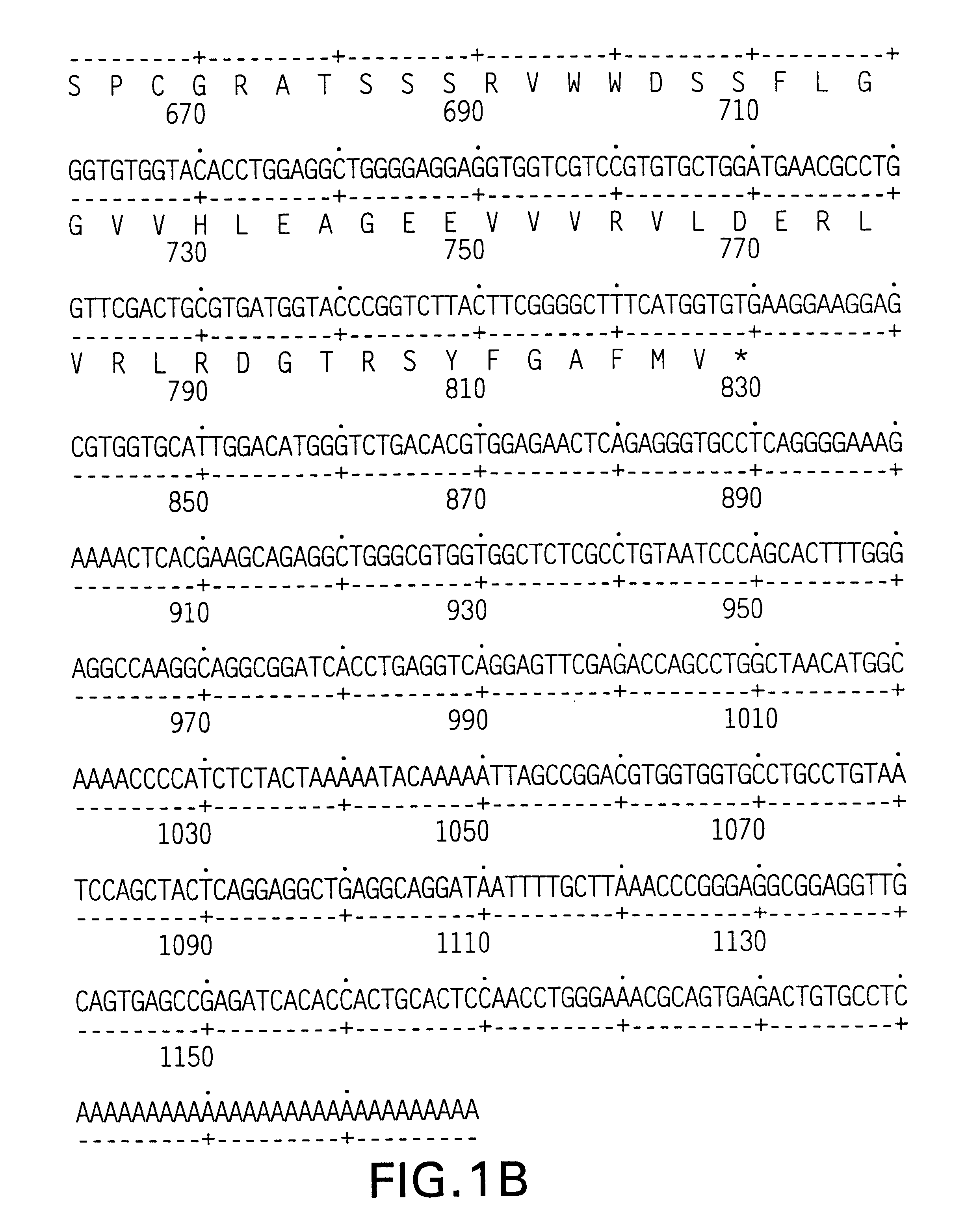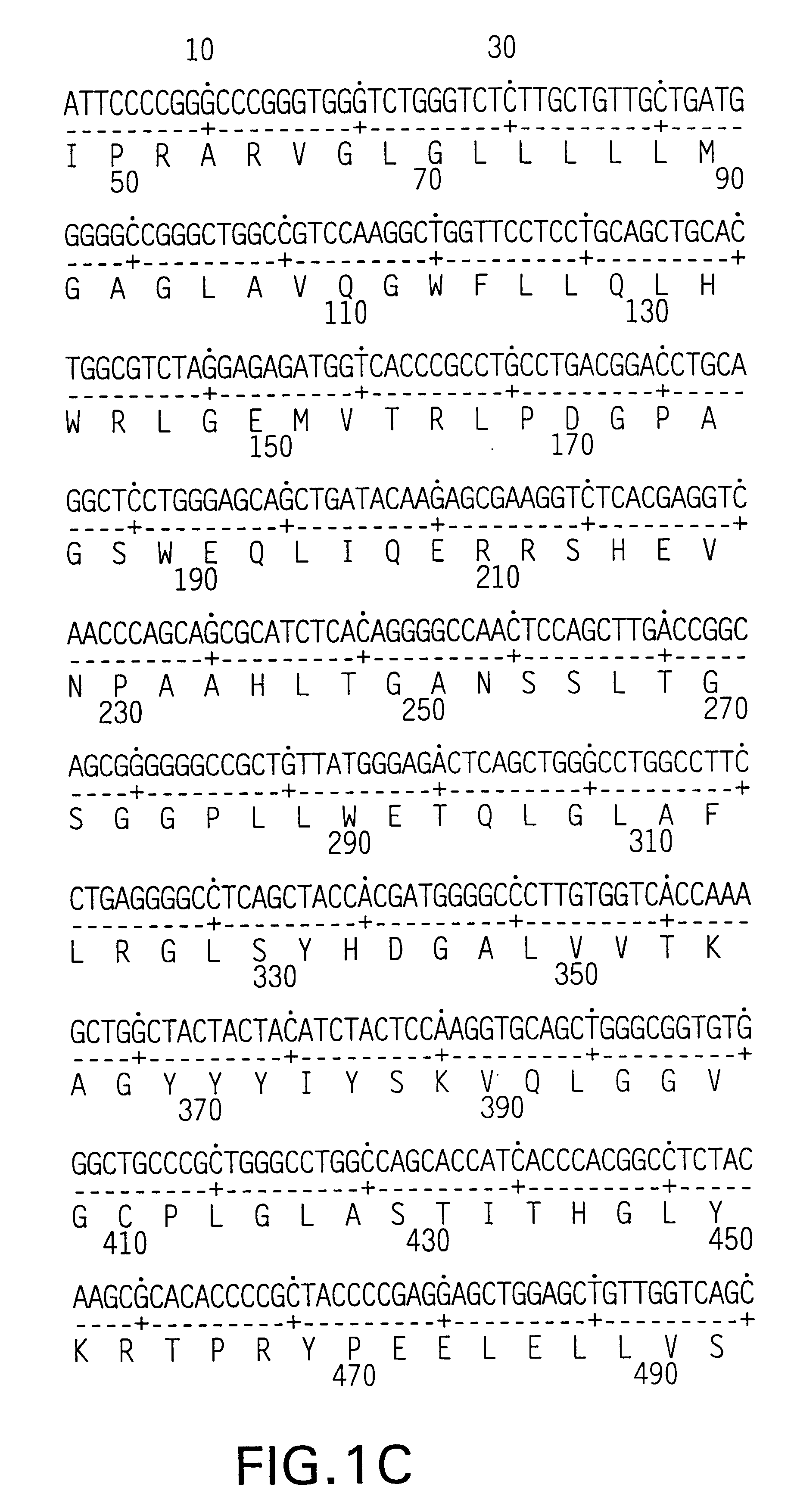Apoptosis inducing molecule II and methods of use
a technology of apoptosis and apoptosis cells, which is applied in the field of apoptosis inducing molecule ii, can solve the problems of apoptosis of cells and the nucleotide sequence determined herein may contain errors
- Summary
- Abstract
- Description
- Claims
- Application Information
AI Technical Summary
Problems solved by technology
Method used
Image
Examples
example 1
Expression and Purification of AIM II in E. coli
A. Expression of AIM II With an N-terminal 6-His Tag
The DNA sequence encoding the AIM II protein in the cDNA assigned ATCC Accession No. 97689 is amplified using PCR oligonucleotide primers specific to the amino terminal sequences of the AIM II protein and to vector sequences 3' to the gene. Additional nucleotides containing restriction sites to facilitate cloning are added to the 5' and 3' sequences respectively.
A 22 kDa AIM II protein fragment (lacking the N-terminus and transmembrane region) is expressed using the following primers:
The 5' oligonucleotide primer has the sequence 5' GCGGGATCCGGAGAGATGGTCACC 3' (SEQ ID NO:7) containing the underlined BamHI restriction site, which includes nucleotides 244-258 of the AIM II protein coding sequence in FIG. 1A (SEQ ID NO:1).
The 3' primer has the sequence: 5' CGCAAGCTTCCTTCACACCATGAAAGC 3' (SEQ ID NO:8) containing the underlined HindIII restriction site followed by nucleotides complementary...
example 2
Cloning and Expression of AIM II Protein in a Baculovirus Expression System
A. Cloning and Expression of a Full Length AIM II Protein:
The cDNA sequence encoding the full length AIM II protein in the deposited clone assigned ATCC Accession No. 97689 is amplified using PCR oligonucleotide primers corresponding to the 5' and 3' sequences of the gene:
The 5' primer has the sequence 5' GCT CCA GGA TCC GCC ATC ATG GAG GAG AGT GTC GTA CGG C 3' (SEQ ID NO:11) containing the underlined BamHI restriction enzyme site followed by 22 bases (i.e., nucleotides 49-70) of the coding region for the AIM II protein in FIG. 1A. Inserted into an expression vector, as described below, the 5' end of the amplified fragment encoding AIM II provides an efficient signal peptide. An efficient signal for initiation of translation in eukaryotic cells, as described by Kozak, M., J. Mol. Biol. 196:947-950 (1987) is appropriately located in the vector portion of the construct.
The 3' primer has the sequence 5' GA CGC G...
example 3
Cloning and Expression in Mammalian Cells
Most of the vectors used for the transient expression of the AIM II protein gene sequence in mammalian cells should carry the SV40 origin of replication. This allows the replication of the vector to high copy numbers in cells (e.g., COS cells) which express the T antigen required for the initiation of viral DNA synthesis. Any other mammalian cell line can also be utilized for this purpose.
A typical mammalian expression vector contains the promoter element, which mediates the initiation of transcription of mRNA, the protein coding sequence, and signals required for the termination of transcription and polyadenylation of the transcript. Additional elements include enhancers, Kozak sequences and intervening sequences flanked by donor and acceptor sites for RNA splicing. Highly efficient transcription can be achieved with the early and late promoters from SV40, the long terminal repeats (LTRs) from Retroviruses, e.g., RSV, HTLVI, HIVI and the ear...
PUM
| Property | Measurement | Unit |
|---|---|---|
| Fraction | aaaaa | aaaaa |
| Length | aaaaa | aaaaa |
| Composition | aaaaa | aaaaa |
Abstract
Description
Claims
Application Information
 Login to View More
Login to View More - R&D
- Intellectual Property
- Life Sciences
- Materials
- Tech Scout
- Unparalleled Data Quality
- Higher Quality Content
- 60% Fewer Hallucinations
Browse by: Latest US Patents, China's latest patents, Technical Efficacy Thesaurus, Application Domain, Technology Topic, Popular Technical Reports.
© 2025 PatSnap. All rights reserved.Legal|Privacy policy|Modern Slavery Act Transparency Statement|Sitemap|About US| Contact US: help@patsnap.com



